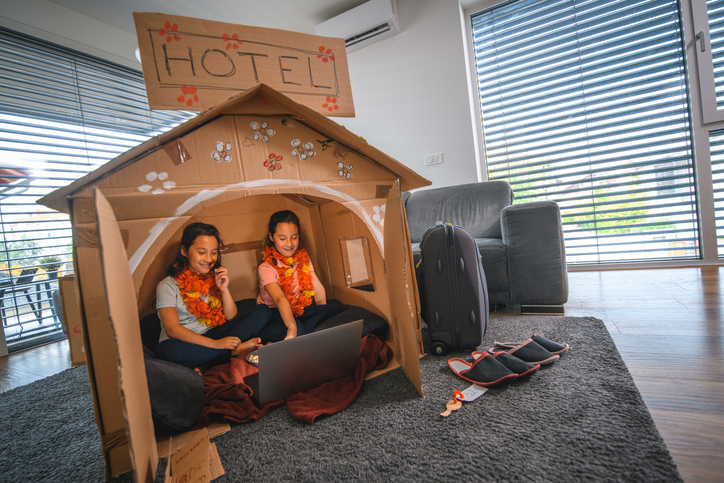Building a cardboard box city with my kids was one of the most memorable summer adventures we’ve ever had. It all started on a lazy Saturday afternoon when the sun was blazing outside, and my kids were bouncing around the house, full of energy. I knew we needed an activity – something creative, something fun, and, ideally, something that wouldn'tinvolve us melting in the heat.
I glanced at a pile of cardboard boxes sitting in the garage from a recent delivery spree. That’s when the idea hit me – why not turn those boxes into something imaginative? I pitched the idea to my kids, and their eyes lit up instantly. Not only could we build something together, but it would be an entire city of our design. I had no idea just how much fun we were about to have.
Step One: Gathering Supplies and Setting Up
The first step was gathering all the materials we’d need. We didn’t overthink it; we just grabbed what we had around the house. The essentials were, of course, the cardboard boxes. Big ones, small ones, some long and thin – we left no box behind. We also grabbed scissors, duct tape, markers, glue, paint, and anything else that seemed remotely useful.
We cleared a spot in the living room, laying down an old bedsheet to protect the floor from any inevitable mess. The kids were already arguing over whether we should build a skyscraper or a supermarket first. I suggested we start by mapping out our city to make sure everyone’s ideas had a place. This turned out to be one of the best decisions of the day.
Step Two: Designing the Layout
We used a big piece of paper to sketch out our city’s layout. My youngest wanted a park with a playground. My oldest, who’s currently obsessed with superheroes, insisted we needed a superhero headquarters. Meanwhile, I suggested some practical additions like houses, a grocery store, and a bridge connecting neighborhoods. The kids laughed at my "boring" ideas but eventually agreed.
This part of the activity was pure magic. Their imaginations ran wild, and I found myself getting just as excited. Why stop at a park when we could add a zoo? Why have just one superhero HQ when the villains needed a lair, too? By the time we finished, we had a detailed plan that covered half the living room floor.
Step Three: Construction Begins
Once the plan was set, it was time to start building. This was where the real challenge – and fun – began. I cut open the boxes while the kids worked on decorating them. My oldest painted windows on what would become our skyscraper, while my youngest covered the park with bright green marker scribbles that we all agreed were “grass.”
The superhero headquarters was a group effort. We stacked boxes high, taping them together to form a tower. My daughter insisted on adding a rooftop landing pad for imaginary helicopters. Meanwhile, my son decided to create a tiny trapdoor that, in his words, “only the good guys can use.” I had no idea cardboard could spark so much creativity.
Step Four: Problem-Solving Along the Way
Of course, not everything went smoothly. One of our houses collapsed when we tried to stack too many boxes on top of it. The bridge we built between neighborhoods kept leaning to one side no matter how much tape we used. And don’t get me started on the zoo – trying to create animal enclosures out of cardboard fences turned into a comedy of errors.
But honestly, the mistakes made it even more fun. Each problem became an opportunity to think outside the box (pun intended). The kids came up with solutions I would never have thought of, like using plastic straws from the kitchen to reinforce the bridge. It was a reminder that creativity thrives in imperfection.
Step Five: Adding Details
With the major structures complete, it was time to bring the city to life. We added details that made it feel real, like drawing roads on black construction paper and adding little signs to our buildings. My daughter created tiny cardboard benches for the park, while my son insisted on building a traffic light out of toilet paper rolls.
We even dug through the toy box to find action figures, cars, and animals to populate our city. The superhero HQ was overrun with plastic dinosaurs by the time we were done, but nobody seemed to mind. Watching the kids bring their world to life was the highlight of the day.
Step Six: Playing in the Cardboard City
Once the city was fully built, it wasn’t just a piece of art – it became the setting for hours of play. The kids made up elaborate stories about their superheroes battling villains, animals escaping the zoo, and families shopping at the grocery store. I joined in, acting as the grumpy shopkeeper who kept running out of ice cream.
The beauty of the cardboard city was that it wasn’t static. Over the next few days, we added new buildings, repaired old ones, and expanded into new “neighborhoods.” It became an evolving project that kept the kids entertained long after that first day of construction.
Step Seven: Lessons Learned
Looking back, building a cardboard box city was so much more than just a way to pass the time. It taught my kids – and me – some valuable lessons. They learned about teamwork as they worked together to solve problems and build structures. They discovered the joy of turning simple materials into something extraordinary. And I was reminded of the power of imagination, something we adults sometimes lose sight of in our busy lives.
Wrapping Up the Adventure
Eventually, our cardboard city had to come down. We took it apart piece by piece, recycling the materials and saving a few favorite pieces as keepsakes. But the memories we made? Those will last forever.
If you’re looking for a fun, creative way to spend a summer day with your kids, I can’t recommend this activity enough. All it takes is a few cardboard boxes, some basic supplies, and a willingness to let your imagination run wild. Trust me – your kids will love it, and you might just have the time of your life, too.


